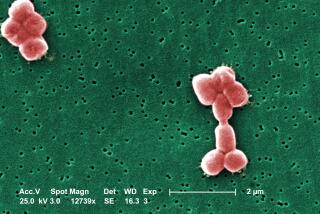New Drug for Sepsis Could Save 50,000 Lives a Year, Experts Say
- Share via
A new drug to fight bacterial infections in the bloodstream could save 50,000 lives per year in the United States, researchers said Friday.
Pharmaceutical companies have been investing huge amounts of time and money to find a drug to combat sepsis, which afflicts 750,000 Americans each year and kills as many as 250,000, but the new drug is the first to show any benefit.
“This is truly a landmark trial,” Dr. Michael Matthay of UC San Francisco said of the new report, which is scheduled to be published in the New England Journal of Medicine next month. The report and an editorial by Matthay were posted on the journal’s Web site, https://www.nejm.org, Friday because of its clinical significance.
Sepsis, once known as blood poisoning, is the leading cause of death in non-cardiac intensive care units in U.S. hospitals. “This research may offer a dramatic advance for critical-care patients and the physicians who treat them,” said Dr. Carolyn Bekes, president of the Society of Critical Care Medicine.
Sepsis can be triggered by a variety of infections, but is most likely to develop in association with trauma, pneumonia, surgery, burns, cancer and AIDS. In fact, those who die from complications of cancer, AIDS and pneumonia most often die from sepsis.
Sepsis is not a simple bacterial infection. When the bacteria get in the bloodstream, they release so-called exotoxins that trigger a host of complications, including inflammation, blood clotting and powerful immune responses that can lead to organ failure.
Even killing the bacteria often cannot halt the process. When they die, the bacteria break open and flood the circulatory system with endotoxins--which are not normally released into the bloodstream while the bacteria are alive--that exacerbate the existing problems.
There currently is no approved treatment for sepsis. In essence, physicians treat individual symptoms, monitor the patients closely and hope that they survive.
Pharmaceutical companies have developed many different products designed to capture and eliminate endotoxins and exotoxins or to remove immune system components from the bloodstream. Some of those treatments have looked quite promising in animal studies, but proved to be dismal failures in human trials.
That is why physicians are so pleased to finally see something that works. “At last, there has been progress,” Matthay said.
The new drug, developed by Eli Lilly, is called drotrecogin alfa (activated) and, when approved by the Food and Drug Administration, will be sold under the brand name Zovant. It is a genetically engineered form of a naturally occurring chemical called protein C that, among other activities, reduces inflammation and inhibits blood clotting--both of which play a crucial role in sepsis.
An international team headed by Dr. Gordon Bernard of Vanderbilt University studied Zovant in 1,690 patients with severe sepsis at 164 medical centers in 11 countries. Half received Zovant intravenously for 96 hours in addition to conventional care and half received only conventional care and a placebo.
The team reported Friday that, after 28 days, 30.8% of the patients receiving a placebo died, compared to only 24.7% of those receiving Zovant.
“It means that for every five people who would normally leave our intensive care unit dead, one of them is going to leave alive now, and I think that is a big difference,” Bernard said. The journal released the paper early so that doctors would know about this new way to fight sepsis.
“This is a very important study,” said Dr. David Gelmont of USC, because it provides a way to treat patients for whom no treatment was previously available.
Those results are even more impressive, Matthay added, because 70% of the patients were in shock when treatment began and 75% were already on breathing machines and had suffered lung damage. The success rate could be significantly higher, he suggested, if patients were treated earlier.
Bernard noted that a higher dose of the drug or longer treatment might also improve the outcome.
Zovant is expected to receive an accelerated review by the FDA, which could lead to approval in as little as six months instead of the normal year or longer. Stock analysts think the market for treating sepsis will be well over $1 billion per year.
But the drug is not for everyone. The researchers noted that it slightly increases the chances of bleeding, so it may not be a good choice for one group of sepsis victims--those who have recently undergone surgery, those who are taking clot-fighting medicines and patients on dialysis.
But that still leaves a large number of sepsis victims for whom it could be a lifesaver, Bernard said.





